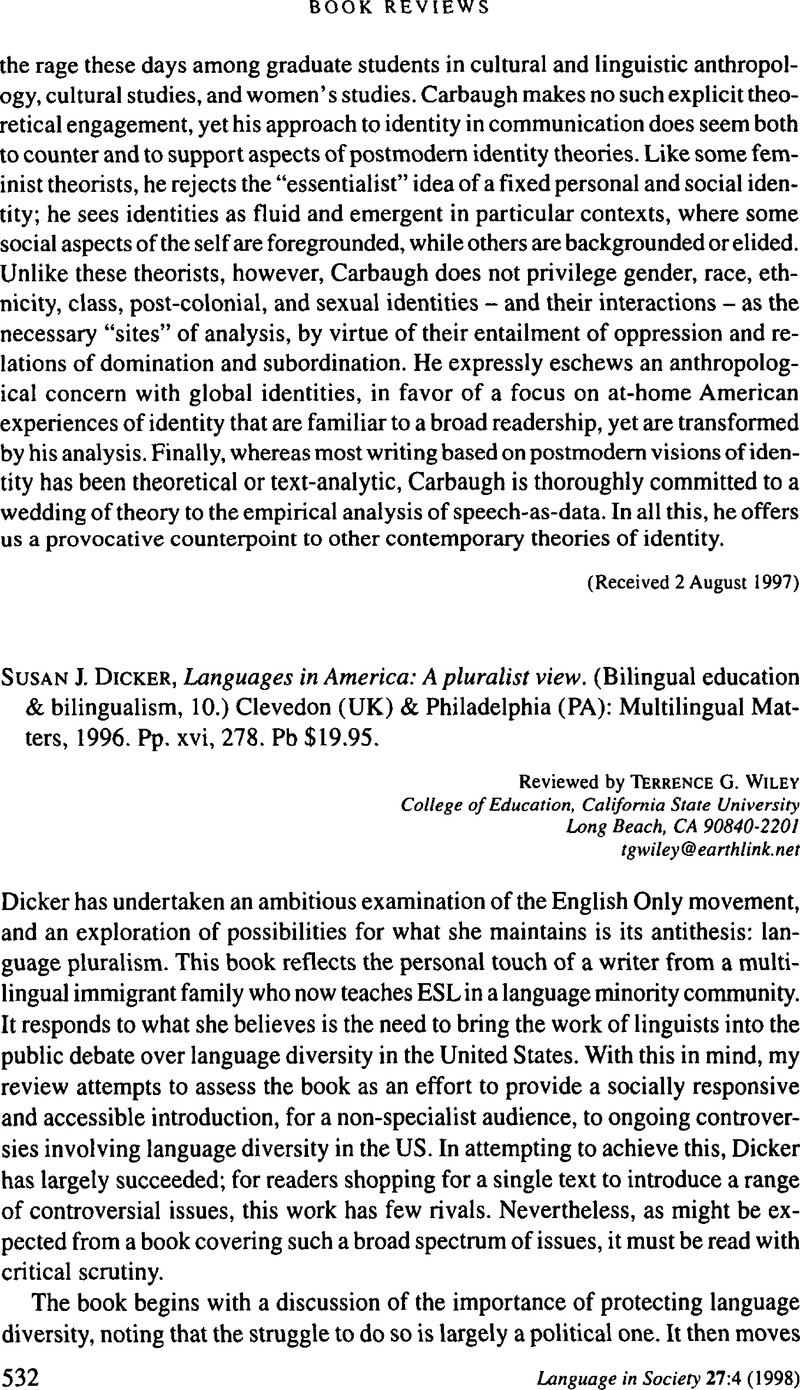No CrossRef data available.
Article contents
Susan J. Dicker, Languages in America: A pluralist view. (Bilingual education & bilingualism, 10.) Clevedon (UK) & Philadelphia (PA): Multilingual Matters, 1996. pp. xvi, 278. Pb $19.95.
Published online by Cambridge University Press: 26 July 2012
Abstract
An abstract is not available for this content so a preview has been provided. Please use the Get access link above for information on how to access this content.

- Type
- Reviews
- Information
- Copyright
- Copyright © Cambridge University Press 1998
References
REFERENCES
Baker, Colin (1996). Foundations of bilingual education and bilingualism. 2nd edn. Philadelphia: Multilingual Matters.Google Scholar
Baker, Keith, & de Kanter, Adriana (1981). Effectiveness of bilingual education: A review of the literature. Washington, DC: Office of Planning & Budget.Google Scholar
Banks, James, & Banks, Cherry (1995), eds, Handbook of research on multicultural education. New York: Macmillan.Google Scholar
Crawford, James (1992a). Hold your tongue: Bilingualism and the politics of “English Only.” Reading, MA: Addison-Wesley.Google Scholar
Crawford, James (1992b). Language loyalties: A source book on the Official English controversy. Chicago, IL: University of Chicago Press.Google Scholar
Crawford, James (1995). Bilingual education: History, Politics, theory, and practice. 3rd ed. Los Amgeles, CA: Bilingual Education Services.Google Scholar
Cummins, Jim (1994). The discoourse of disinfirmation: The debate on bilingual education and language rights in the United States. InSkutnabb-Kangas, Tove & Phillipson, Robert (eds.), Linguistic human rights: Overcoming linguistic discrmination, 159–77. Berlin: Mouton de Gruyter.Google Scholar
Daniels, Robert (1991). Coming to America: A history of immigration and ethnicity in American life. New York: Harper Perennial.Google Scholar
Donald, James, & Rattansi, Ali (1992).eds. “Race,” culture and difference. London: Sage.Google Scholar
Gill, Dawn; Mayor, Barbara; & Blair, Maud (1992). eds. Racism and education: Structures and strategies. London: Sage.Google Scholar
Hollinger, David A. (1995). Postethnic America: Beyond multiculturalism. New York: Basic Books.Google Scholar
Porter, Rosalie (1990). Forked tongue: The politics of bilingual education. New York: Basic Books.Google Scholar
Ravitch, Diane (1990). Multiculturalism: E Pluribus Plures. American Scholar 59:337 –54.Google Scholar
Ramírez, J. David (1992). Executive summary. Bilingual Research Journal 16:1/2.1–62.CrossRefGoogle Scholar
Sleeter, Christine, & Grant, Carl (1987). An analysis of multicultural education in the United States. Harvard Educational Review 57:421–44CrossRefGoogle Scholar
Willig, Ann (1985). A meta-analysis of selected studies on the effectiveness of bilingual education. Review of Educational Research. 55:269–317.CrossRefGoogle Scholar




